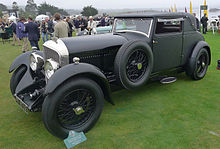Weymann body
The Weymann body is a vehicle body with a wooden frame and synthetic leather cover that was used between the early 1920s and the late 1950s. The aircraft designer Charles Weymann (1887–1976) owned the associated patents .
technology

Since the roads were not asphalted at that time and the vehicles were usually provided with twistable ladder frames , the steel or aluminum bodies often tended to crack. They also caused annoying squeaking noises while driving. Weymann developed a body that had only a few connection points with the vehicle frame and whose wooden framework was not rigid. The individual wooden parts were covered with rubber and held together with metal straps. Where wood and metal met, oil-separating paper was placed in between to dampen noise. This enabled the superstructure to follow the deformation of the chassis without rattling or squeaking. The inside of the body was planked with plywood and the gaps filled with insulating material. The outside of the body was covered with varnished synthetic leather. The seats were not connected to the body, but to the chassis. Weymann also held a patent for a backrest adjustment with adjustable back cushions.
Only the fenders and the hood were made of metal. However, there were often problems with the accuracy of fit with the doors and windows. Weymann bodies were built until the end of 1935.
The Weymann body was an alternative to the wood / steel composite construction. It was significantly lighter, cheaper to manufacture and quieter than previous body styles. Only the durability left a lot to be desired. The stiffer all-steel body, which was introduced from 1927, largely replaced the Weymann bodies.
Production and Licenses
Weymann founded a company in Paris in 1922 that manufactured car bodies based on its own design features.
Great Britain
In 1923 a sister company in Great Britain was added, which initially only had the purpose of selling licenses to British bodywork manufacturers. Weymann quickly won numerous licensees, including established ones such as Gurney Nutting and Windover. Regardless of this, Weymann began manufacturing car bodies in Great Britain in 1925. The British subsidiary Weymann's Motor Bodies Ltd. For this purpose, took over the established bodywork manufacturer Cunard in the London borough of Putney . The company grew until 1928 when it moved to new facilities in Addlestone . From 1929, however, the demand for Weymann bodies dropped sharply, so that the body shop was closed in 1932.
Weymann licensees in the UK included Albany Carriage , Arnold of Manchester , Carlton , Chalmer & Hoyer , Charlesworth , Freestone & Webb , Gill , Harrington , Lancefield , Mann Egerton & Co. Ltd. , Maythorn , HJ Mulliner & Co. , J. Gurney Nutting , Park Ward , Rippon , Surbico and James Young .
Germany
Another subsidiary existed in Germany ( Weymann Karosserie GmbH in Cologne, 1924 to 1930). Glasses , Papler , Kühlstein and Reutter were among the German licensees .
United States
Weymann bodies were also widespread in the USA . The licenses were administered here by the Weymann American Body Company in Indianapolis .
Similar designs
Until well after the Second World War , car bodies were still made using a wooden frame construction. However, the wooden frames were firmly attached and not built according to the Weymann principle. Vehicles with a wood-synthetic leather body were available from Lloyd and DKW, for example .
literature
- Werner Oswald : German Cars 1920–1945 . 10th edition. Motorbuch Verlag Stuttgart, 1996, ISBN 3-87943-519-7 .


